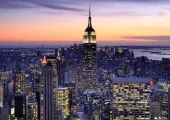New York City Transit and the New Moynihan Train Hall
Catalogue
- Arriving in New York City
- By Air
- By Train
- Grand Central Terminal
- Penn Station and the Moynihan Train Hall
- Getting Around New York City
- By Subway
- By Bus
- Other Options
- Roosevelt Island Tram
- Staten Island Ferry
- Citi Bike NYC
Show More
Bright lights, broad avenues, and an irresistible allure help make New York City arguably the greatest city in the world. Sure there’s London, Paris, and Tokyo, but none of those places match the frenetic energy of a city seemingly perched on the edge of danger. New York’s rough and tumble attitude belies a tenderness that comes through in surprising ways. To discover hidden New York gems, you need an ability to efficiently move around the city. Fortunately, the Big Apple is the one city in the United States with a rather comprehensive transit system. Anchored by the largest public transportation agency in North America, New York’s subways and busses reach deep into the city’s five boroughs: Manhattan, the Bronx, Brooklyn, Queens, and Staten Island. Add in a ferry service, commuter and national railway networks, plus a bike sharing program and you’ve got impressive mobility -- all without ever having to get in a car. In this article we’re taking a closer look at how to get around New York City, including spotlighting Pennsylvania Station’s just-completed $1.6 billion renovation and construction of the new Moynihan Train Hall. Let’s get started.

New York is served by three major airports: John F. Kennedy International Airport (JFK), LaGuardia Airport (LGA), and Newark Liberty International Airport (EWR). Both LaGuardia and Kennedy are located within New York City proper and are relatively easy to access via the public transportation system. LaGuardia sits across the Hudson River in Newark, New Jersey. Passengers can get into Manhattan from LaGuardia via connections to the AirTrain Newark monorail system and New Jersey Transit’s commuter rail services or Amtrak. Once you’ve arrived in New York City, it’s a straightforward matter to access the main MTA subway and bus networks.

Essentially, travelers can reach New York City aboard two types of trains: traditional passenger railroad and suburban commuter rail services. The former is supplied by Amtrak while the latter includes the MTA Long Island Rail Road, MTA Metro-North Railroad, New Jersey Transit, and others. There are two primary railroad terminals in New York City: Grand Central Terminal and Pennsylvania Station (aka Penn Station). A few additional stations within the city limits are served by passenger rail connections including Jamaica station in Queens and Harlem-125th Street station in Manhattan. The vast bulk of passengers traveling by rail, however, will arrive into New York City via one of the two primary terminals.
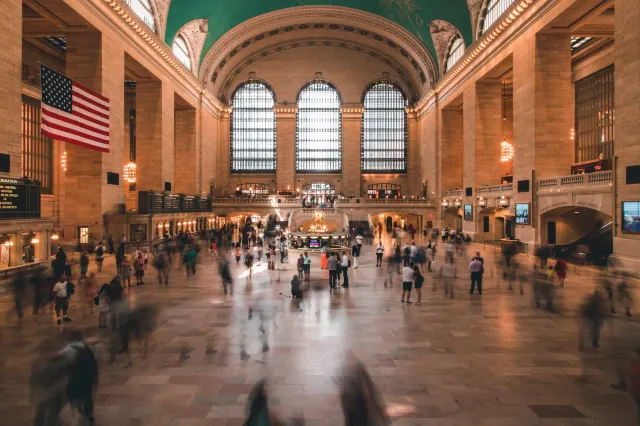
At 42nd Street and Park Avenue is where one finds the fabled Grand Central Terminal. Day in, day out suburban commuters pour through Grand Central. At its peak, 65 million passengers passed under the main concourse's barrel vaulted ceiling. Make a point to pause in the great hall and admire the elaborate celestial mural containing over 2,500 stars set in golden bands against a turquoise backdrop. When sunlight streams through large windows in long shafts extending to the floor below, Grand Central takes on the grandeur that earned it its name. The station features a range of upscale shopping and dining, and with its many connections to commuter rail and subway networks, Grand Central is an easy and convenient way into and out of New York City. If you’re traveling on the MTA Metro-North Railroad, chances are you’re going to pass through Grand Central at some point. Might as well take a moment to appreciate one of the city’s top attractions. A hidden gem tucked away is the Vanderbilt Tennis Club, an often overlooked recreational facility on the 4th floor. Open to the public, it can be something of a thrill to play on a court set behind Grand Central’s fabled exterior windows. Plus you can relish the challenge of actually finding the entrance to the club, no mean feat in itself.
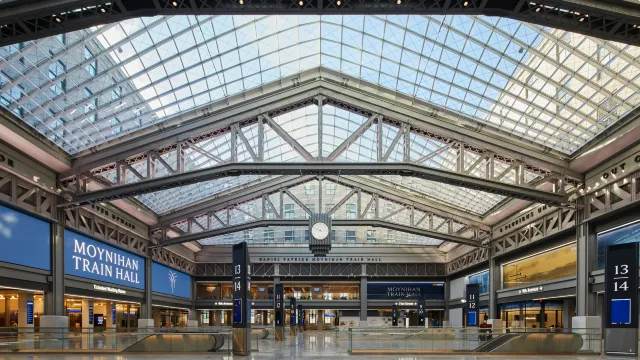
Prior to construction of the brand new Moynihan Train Hall, Penn Station was known as a place to avoid if at all possible. Despite being the busiest railroad station in the Western Hemisphere, Penn Station had a reputation for being cramped, crowded, and not very appealing. Following the opening on January 1, 2021, of the new Moynihan Train Hall, Penn Station’s concourse capacity expanded by roughly 50% and the station regained some of its former grandeur. The $1.6 billion renovation converted for use a large portion of New York City’s main United States Postal Service building on Eighth Avenue between 31st Street and 33rd Street. The Moynihan Train Hall features extensive use of natural light in a beautiful glass-vaulted atrium. The atrium’s massive steel trusses evoke Penn Station’s heyday, prior to the original building’s demolition in 1963 to make way for Madison Square Garden. Amtrak and the Long Island Rail Road lines will use concourses in the Moynihan Train Hall, while New Jersey Transit lines will continue into the old Penn Station. New facilities located in the Moynihan Train Hall should greatly improve the traveler experience. Amtrak passengers can enjoy the new Metropolitan Lounge, a premium space with various food and beverage options and dedicated customer service agents.
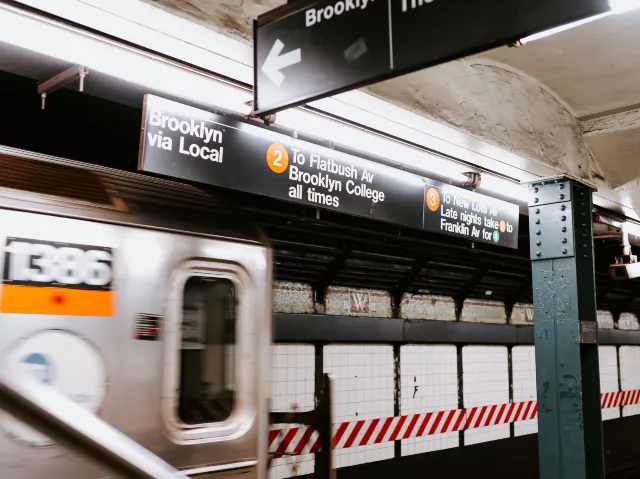
The New York City Subway is often called the lifeblood of the city. Operating 24/7 throughout most of its existence, there were normally trains coursing along 245 miles of routes at all hours. This easily made the subway the most convenient and cost-effective way to get around. Of course, COVID-19 has managed to upend even this. For the time being, subway service is suspended each night between 1:00 a.m. and 5:00 a.m. to facilitate cleaning and disinfecting the train cars. Historically, the New York City Subway was not one unified system, it was rather a confusing and sometimes complex amalgamation consisting of two private and one public system that were eventually consolidated in 1940. This legacy resulted in a contemporary system that appears hopelessly complex and frustrating to first-time riders. One glance at the subway map reveals a tangle of colored ribbons draped across the city and festooned with strange letters, numbers, and symbols. Fortunately, with a modicum of fortitude, you’ll find yourself easily swapping between express and local trains as you bounce around town. A few basic tips to keep in mind include the following:
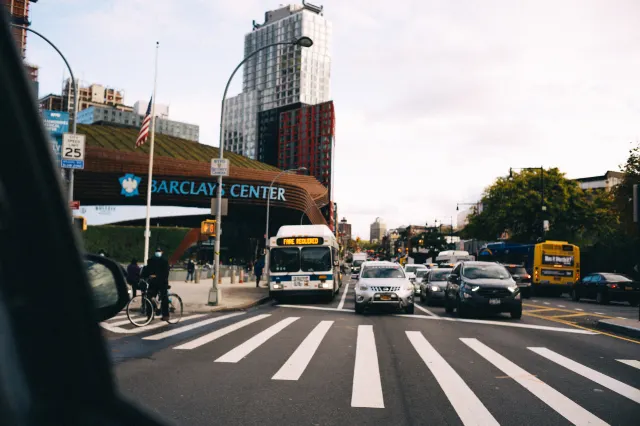
NYC’s other primary mode of public transportation is the New York City Bus. Also operated by the Metropolitan Transportation Authority (MTA), moving between the subway and the surface bus fleet is relatively seamless. An MTA MetroCard will get you access to both services. Some bus lines also feature contactless payment options. Navigating New York City by bus can be quite rewarding and an inexpensive way to see different parts of the city. Learning exactly where to go and which bus to take is arguably a bit more challenging than learning how to master the subway; however, modern navigation apps much as Google Maps or Apple Maps do a decent job incorporating public transportation information into routing directions. Alternatively, you can consult the MTA website and use their interactive trip planner to get detailed instructions on which buses to take in order to reach your desired destination. For visitors to the city, it’s helpful to consider the buses as a compliment to the subway rather than existing as a separate alternative. Sometimes you may need to travel a bit further beyond the nearest subway stop. In these instances, as well as generally on Staten Island where there is no subway network beyond the single-line Staten Island Railway, buses are extremely helpful. Typically, the standard bus fare is also $2.75 with some express bus services charging $6.75 for a single trip.
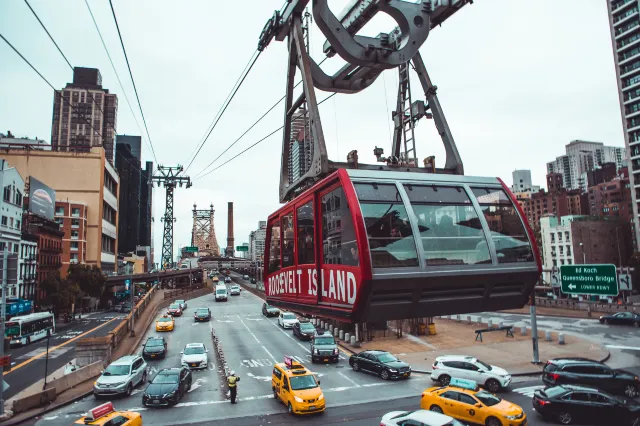
Located in the East River, Roosevelt Island is a fun little stop that’s officially part of Manhattan. Take the Roosevelt Island Tram, which you can access with your MTA MetroCard. The tram takes you up and over to the island while providing a great sightseeing opportunity including stunning views of the Queensboro Bridge and Manhattan skyline. Take a walk to the island’s southern tip and the Franklin D. Roosevelt Four Freedoms Park from where you’ll have excellent views of the United Nations Headquarters and the famous Pepsi Cola sign. You can also see the now abandoned Smallpox Memorial Hospital. Once you’re done, head north and take the subway back into Manhattan or Queens.
NYC Ferry

The NYC Ferry is a network of ferry routes that move passengers between 21 separate piers scattered along the waterfronts in the Bronx, Brooklyn, Manhattan, and Queens. NYC Ferry routes are exclusively found along the East River and Upper Bay of New York Harbor. Outside winter months, navigating along the East River is a fantastic way to see the Manhattan skyline while also moving around. Take the East River line and sail under the Brooklyn and Manhattan Bridges as you work your way north from Wall Street Pier 11. This is a great way to see the sights and get some excellent pictures. Plus you can also explore trendy Williamsburg.

Staten Island is New York City’s most remote and difficult to access borough. Despite this, there are a number of seaside parks and gardens that make a visit to Staten Island well worth the trouble. For visitors who want to trek over, the best way to do so is aboard the Staten Island Ferry. The free ferry runs between Whitehall Terminal in Lower Manhattan and St. George Ferry Terminal on Staten Island. As a bonus, the ferry passes near Liberty Island on its journey through New York Harbor. A somewhat touristy thing to do is to imagine what it must have been like sailing into New York Harbor for the first time as a wide-eyed immigrant looking for a new life in the land of opportunity.
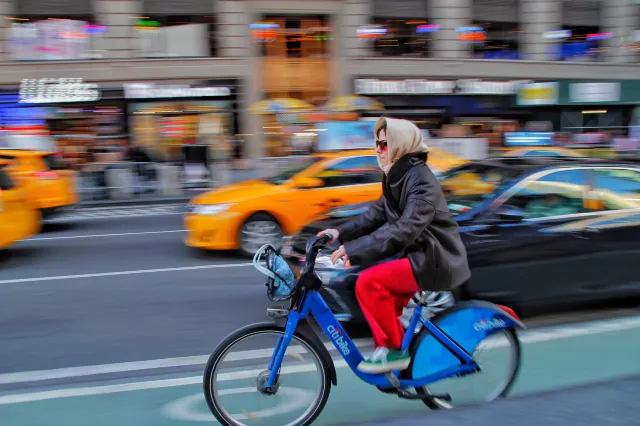
Citi Bike is a private bicycle sharing program owned by Lyft. The network of Citi Bike stations has expanded considerably since the system first launched in 2013. One look at the station map today shows a high-density throughout major trafficked areas in Manhattan, Brooklyn, the Bronx, and parts of Queens. Usage rates vary and day-passes are available for $15, which entitle holders to unlimited 30-minite rides on classic Citi Bike models. Extra costs are incurred for longer rides or to upgrade to an e-bike. In order to access Citi Bike, you will need to either download the mobile app or follow the payment instructions at the automatic kiosks found at City Bike stations. As New York City has moved to expand greenways, pedestrian access, and dedicated bike lanes, getting around by bike is not only fun, it’s also practical.
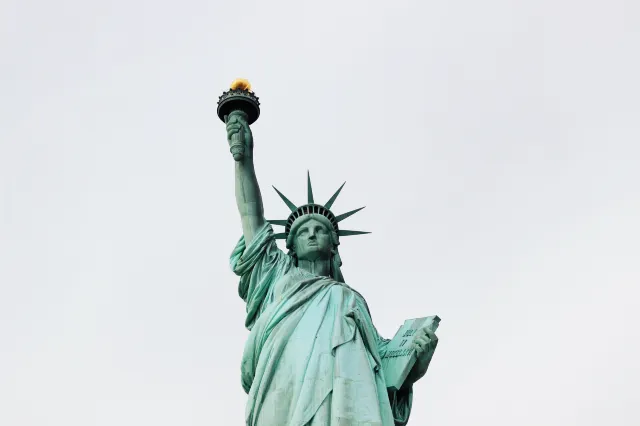
The Big Apple is an amazing place and the exhilaration visitors feel can be palpable. As you’re considering how to make the most of your next trip to New York City, combine the practical information in this guide with our lists of great things to see. In high-density places like Manhattan, you’ll have no trouble getting around via public transportation. Even if it’s a bit more challenging in the outer boroughs, New York City is easily navigable by combining the options we’ve covered here. As we mentioned at the outset, New York is arguably the one place in the entire United States with a comprehensive public transportation system comparable to those found in major European and Asian cities. Come discover what makes New York City such a global treasure. No matter what you’re searching for, you can find it in New York. We know once you visit, you won’t want to leave.
Trending Travelogues
Popular Trip Moments
Popular Travel Types
Popular Attractions
Popular Destinations
Recommended Attractions at Popular Destinations







Site Operator: Trip.com Travel Singapore Pte. Ltd.



